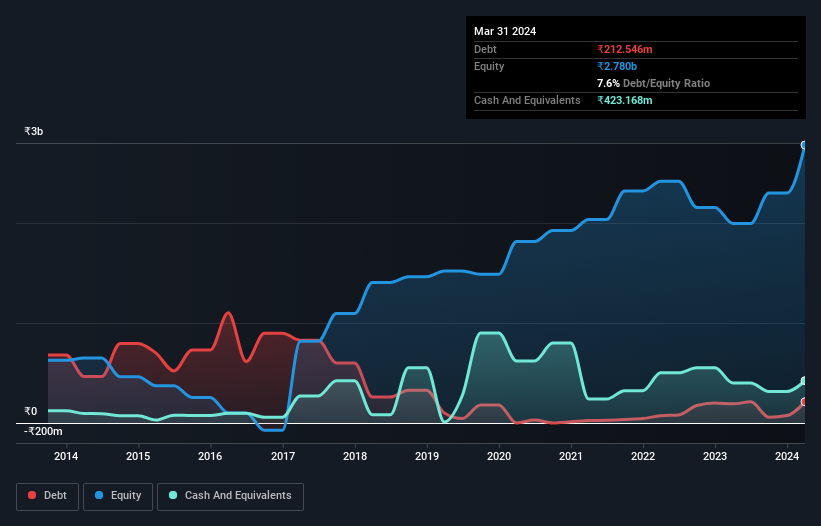
Howard Marks put it nicely when he said that, rather than worrying about share price volatility, 'The possibility of permanent loss is the risk I worry about... and every practical investor I know worries about.' So it seems the smart money knows that debt - which is usually involved in bankruptcies - is a very important factor, when you assess how risky a company is. We note that Asian Energy Services Limited (NSE:ASIANENE) does have debt on its balance sheet. But the real question is whether this debt is making the company risky.
When Is Debt A Problem?
Generally speaking, debt only becomes a real problem when a company can't easily pay it off, either by raising capital or with its own cash flow. In the worst case scenario, a company can go bankrupt if it cannot pay its creditors. However, a more frequent (but still costly) occurrence is where a company must issue shares at bargain-basement prices, permanently diluting shareholders, just to shore up its balance sheet. Having said that, the most common situation is where a company manages its debt reasonably well - and to its own advantage. When we think about a company's use of debt, we first look at cash and debt together.
View our latest analysis for Asian Energy Services
What Is Asian Energy Services's Debt?
The image below, which you can click on for greater detail, shows that at March 2024 Asian Energy Services had debt of ₹212.5m, up from ₹191.4m in one year. But on the other hand it also has ₹423.2m in cash, leading to a ₹210.6m net cash position.

How Healthy Is Asian Energy Services' Balance Sheet?
The latest balance sheet data shows that Asian Energy Services had liabilities of ₹1.02b due within a year, and liabilities of ₹46.8m falling due after that. On the other hand, it had cash of ₹423.2m and ₹1.62b worth of receivables due within a year. So it can boast ₹974.8m more liquid assets than total liabilities.
This surplus suggests that Asian Energy Services has a conservative balance sheet, and could probably eliminate its debt without much difficulty. Simply put, the fact that Asian Energy Services has more cash than debt is arguably a good indication that it can manage its debt safely.
Although Asian Energy Services made a loss at the EBIT level, last year, it was also good to see that it generated ₹248m in EBIT over the last twelve months. When analysing debt levels, the balance sheet is the obvious place to start. But you can't view debt in total isolation; since Asian Energy Services will need earnings to service that debt. So if you're keen to discover more about its earnings, it might be worth checking out this graph of its long term earnings trend.
But our final consideration is also important, because a company cannot pay debt with paper profits; it needs cold hard cash. Asian Energy Services may have net cash on the balance sheet, but it is still interesting to look at how well the business converts its earnings before interest and tax (EBIT) to free cash flow, because that will influence both its need for, and its capacity to manage debt. During the last year, Asian Energy Services burned a lot of cash. While that may be a result of expenditure for growth, it does make the debt far more risky.
Summing Up
While it is always sensible to investigate a company's debt, in this case Asian Energy Services has ₹210.6m in net cash and a decent-looking balance sheet. So we don't have any problem with Asian Energy Services's use of debt. When analysing debt levels, the balance sheet is the obvious place to start. But ultimately, every company can contain risks that exist outside of the balance sheet. For instance, we've identified 2 warning signs for Asian Energy Services (1 is significant) you should be aware of.
When all is said and done, sometimes its easier to focus on companies that don't even need debt. Readers can access a list of growth stocks with zero net debt 100% free, right now.
New: Manage All Your Stock Portfolios in One Place
We've created the ultimate portfolio companion for stock investors, and it's free.
• Connect an unlimited number of Portfolios and see your total in one currency
• Be alerted to new Warning Signs or Risks via email or mobile
• Track the Fair Value of your stocks
Have feedback on this article? Concerned about the content? Get in touch with us directly. Alternatively, email editorial-team (at) simplywallst.com.
This article by Simply Wall St is general in nature. We provide commentary based on historical data and analyst forecasts only using an unbiased methodology and our articles are not intended to be financial advice. It does not constitute a recommendation to buy or sell any stock, and does not take account of your objectives, or your financial situation. We aim to bring you long-term focused analysis driven by fundamental data. Note that our analysis may not factor in the latest price-sensitive company announcements or qualitative material. Simply Wall St has no position in any stocks mentioned.
Have feedback on this article? Concerned about the content? Get in touch with us directly. Alternatively, email editorial-team@simplywallst.com
About NSEI:ASIANENE
Asian Energy Services
Provides services to energy and mineral sectors primarily in India.
Excellent balance sheet with proven track record.
Market Insights
Community Narratives



